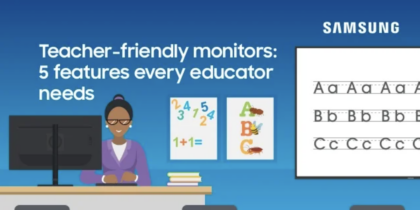The COVID-19 pandemic and its resulting school closures brought about a widespread shift toward remote learning, and left teachers in largely uncharted waters. As teachers struggled to expand their digital skills and move classes online, districts looked for ways to support them with extra training, technical assistance and professional development. While remote learning remains the norm, administrators need to double down on their efforts to support teachers and help their students succeed.
Here are a few tips to help you give teachers the best possible professional development options:
1. Assess their needs
Start by assessing your teachers’ comfort level with different technology tools. The Massachusetts Technology Self-Assessment Tool can give teachers immediate insight into their level of proficiency with technology, and it can help administrators identify the most pressing needs for professional development. The assessment covers the basics of computer and internet usage, word processing and online communication, as well as technology ethics and safety. Once everyone has taken the assessment, you can use the results to sort teachers into groups based on their areas of proficiency and need for training.
17 innovative lesson ideas for remote learning
Get your free pack of multidisciplinary lesson plans to teach modern students with modern tools. Download Now
2. Consult ISTE educator standards
Before you choose or create new professional development programs, consult the International Society for Technology in Education (ISTE) Standards for Educators, a set of guidelines for teachers looking to incorporate technology in their lessons. The ISTE standards emphasize collaboration, data analysis, digital citizenship and efforts to empower students to use educational technology to take ownership of their learning. These standards can serve as building blocks for your own professional development programs and can help you focus teachers’ training on the areas where they have the most room for growth.
3. Provide targeted professional development programs
Even before the pandemic, hourlong seminars on in-service days were questionably effective. And now more than ever, districts must strive to offer professional development options that are compatible with teachers’ individual learning styles and needs.
Virtual professional development services, such as OTIS for educators, offer a course library that educators can pick and choose from based on what they need help with. For example, one teacher might need to sharpen their Google Classroom skills, while another teacher might want tips for planning video-based classes.
Ask educators what they need and how they prefer to learn. Then offer them several options for fulfilling professional development requirements. Some examples include online workshops, mentor-mentee relationships, one-on-one coaching sessions and collaborative or interdisciplinary teaching activities. Some innovative districts are giving teachers instant feedback by watching their classes in real time. For example, an administrator might pop into a teacher’s Zoom class to observe and then privately send the teacher feedback and guidance.
4. Share resources and ideas
The sudden, widespread shift toward remote learning has put stress on everyone involved in education, but it’s also driven them to rise to new challenges. Teachers and districts worldwide are experimenting with innovative technologies and teaching methods, and they’re remotely collaborating with colleagues outside their usual circles.
Encourage teachers to share ideas and resources through educator social media groups and sites like the Teaching Channel. Also connect with other local district leaders; ask about how they’re supporting their teachers and providing professional development. Seek out helpful resources for your teachers working remotely. Here are a few places to start:
- The Organization for Economic Co-operation and Development (OECD) put together an annotated collection of resources for online learning during the pandemic.
- The ISTE and EdSurge launched Learning Keeps Going, an online portal with free resources to support K-12 educators and parents.
- The National Institute for Excellence in Teaching (NIET) has created a collection of educational resources and remote learning guidance.
5. Listen well
Ultimately, helping teachers succeed starts with listening to them and responding to their requests. If you don’t have a way to collect regular feedback and ideas from teachers across your district, build that into your workflow — and hang onto it post-pandemic. For example, you could send teachers form-fill polls or schedule a regular time to meet with them (in groups or individually) to discuss their concerns and hear their suggestions. When district administrators, educators and staff see themselves as a unified team, everyone wins — especially the students.
Help your teachers with their digital lesson plans with this free pack of multidisciplinary lesson ideas. Or see what other digital solutions Samsung offers for remote learning.








